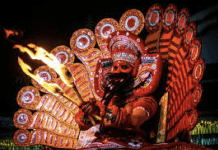Mahalasa Narayani Temple, located in Mardol, Ponda, in the Indian state of Goa, is a revered Hindu temple dedicated to the Goddess Mahalasa Narayani. Shri Mahalasa Narayani, the presiding deity of the temple, is venerated as the powerful Kuladevata (family deity) of numerous Hindus, especially in western and southern India. Mahalasa Narayani is identified with Mohini, the captivating female incarnation of Lord Vishnu. The temple in Mardol, with its remarkable history spanning over 450 years, stands as the most revered abode of Supreme Mother Mahalasa.
Significance and Mythology of the Mahalasa Narayani Temple, Mardol, Goa:
Mahalasa holds great significance in Hindu mythology and is revered in two distinct traditions. Firstly, she is worshipped as an independent goddess in the form of Mohini, the enchantress and female avatar of Lord Vishnu. Secondly, she is revered as Mahalasa Narayani, the spouse of Lord Vishnu. Additionally, Mahalasa is also recognized as the consort of the local deity Khandoba, a form of Lord Shiva. In this aspect, she is associated with both Parvati, the wife of Shiva, and Mohini. It is believed that Mahalasa is a manifestation of Parvati with the divine beauty of Mohini, as requested by Lord Shiva. The iconic form of Mahalasa Narayani features her with four hands, each holding a Trishula (trident), a sword, a severed head, and a drinking bowl. She is depicted standing on a man or demon, while a tiger or lion licks the blood dripping from the severed head. Notably, Mahalasa wears the yajnopavita (sacred thread), a symbol typically associated with male deities. She is worshipped as a young girl in the morning, a maiden at noon, and a woman in the evening. Goud Saraswat Brahmins and Vaishnavas from Goa and South Canara consider her as Mohini and refer to her as Narayani and Rahu-matthani, the slayer of Rahu, as mentioned in the Bhavishya Purana. The legend of Mohini avatar narrates the story of the churning of the ocean of milk by the gods and demons to obtain the elixir of immortality. When the elixir appeared, the demons desired to keep it for themselves. To resolve the situation, Lord Vishnu transformed into the enchantress Mohini, who deceived the demons by promising to distribute the elixir among both gods and demons. However, she cleverly ensured that only the gods received the elixir. In this way, Mohini is worshipped as Mahalasa Narayani, representing her divine and captivating essence.
History of the Mahalasa Narayani Temple, Mardol, Goa:
The temple’s history traces back to a time of upheaval when the Portuguese destroyed Mahalasa’s earlier temple in Old Mardol or Velham in 1567. However, the iconic deity of Mahalasa was safeguarded from destruction and later shifted to the present location in Mardol to evade further harm during the forcible Christianization of Salcette. In the 17th century, a new temple was constructed in Mardol, independent of Portuguese control, and the consecration of the deity took place, reaffirming the significance of Mahalasa Narayani.
Architecture of the Mahalasa Narayani Temple, Mardol, Goa:
The Mahalasa Narayani Temple in Mardol exhibits remarkable architecture and sacred elements. As one enters the temple complex, the intricately designed entrance sets the tone for the spiritual experience. Within the complex, smaller temples dedicated to Shantadurga and Lakshmi Narayan accompany the main deity, Mahalasa Narayani, in daily worship rituals. The temple also features shrines for the five principal attendants of Mahalasa, namely Grampurush, Bhagwati, Dadh, Simha Purush, and Mhal Purush. After the morning and evening aarti, devotees are served Prasad at the temple’s canteen. Notably, the temple’s grand brass bell, known for its absence of a permanent ringer, holds a unique belief that a false testimony given while ringing it will result in the person’s death within three days. This belief was so strong that during the Portuguese era, temple testimony was deemed acceptable in court. Additionally, the temple is renowned for its Brass Divli/Samai, an exquisite oil lamp. The captivating architectural features and sacred artifacts of the Mahalasa Narayani Temple create a profound spiritual ambiance that leaves visitors in awe.
Festivals and Rituals of the Mahalasa Narayani Temple, Mardol, Goa:
The Mahalasa Narayani Temple celebrates numerous festivals with great fervor, uniting devotees in their devotion and joy. The Magha Jatra festival, dedicated to the presiding deity, and Navaratri, a nine-night festival dedicated to the Hindu goddess, are the primary annual celebrations. During these festivals, the temple resonates with the sounds of prayers, devotional songs, and cultural performances. Devotees come together to seek blessings and partake in the vibrant festivities that honor the divine presence of Mahalasa Narayani.
At the Mahalasa Narayani Temple, rituals play a crucial role in expressing devotion and reverence towards the goddess. The daily worship involves offering prayers to Mahalasa Narayani and the accompanying deities within the temple complex. The goddess is adorned in different alankar (ornaments and costumes) that represent various Vishnu-related deities on different days. Sundays hold special significance, marked by the Palakhi Seva, where the goddess is carried in a palanquin adorned with flowers and colorful decorations. Devotees participate in the procession, singing hymns and expressing their devotion.
Temple Timings:
The Mahalasa Temple is open from 6:30 AM to 8:30 PM. The daily Aarti (religious ritual) timings are at 12:30 PM and 8:30 PM.
How to Reach Mahalasa Temple Goa:
By Air:
The nearest airport to Mahalasa Temple is Goa International Airport, also known as Dabolim Airport. It is located approximately 30 km away from the temple. From the airport, you can hire a taxi or take a pre-paid cab to reach Mardol where the temple is situated.
By Rail:
The closest railway station to Mahalasa Temple is Karmali Railway Station, which is about 17 km away. It is well-connected to major cities in India, including Mumbai, Delhi, and Bangalore. From the railway station, you can hire a taxi or take a local bus to reach the temple.
By Road:
Mardol, where the Mahalasa Temple is located, is well-connected by road. It is situated near National Highway 4A, which connects various towns and cities in Goa. You can reach Mardol by taking a taxi, hiring a self-drive car, or using state-run buses that operate on this route. It is approximately 22 km from Panjim, 9 km from Ponda, and can be easily reached from other parts of Goa as well.
























































